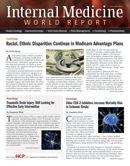Publication
Article
Internal Medicine World Report
Racial, Ethnic Disparities Continue in Medicare Advantage Plans
Author(s):
A nationwide study of elderly enrollees in Medicare Advantage health plans concluded that disparities in control of blood pressure, cholesterol, and glucose had not improved nationally for blacks in these plans despite the disparities being eliminated in the US west in 2011.

A nationwide study of elderly enrollees in Medicare Advantage health plans concluded that disparities in control of blood pressure, cholesterol, and glucose had not improved nationally for blacks in these plans despite the disparities being eliminated in the US west in 2011.
Investigators assessed differences in control of blood pressure, cholesterol, and glucose according to race or ethnic group in 2006 and 2011 and evaluated how these differences were related to differences in performance among geographic regions and health plans. The study also compared disparities in Kaiser Permanent health plans with disparities in non-Kaiser health plans, because earlier studies showed major improvements in the care of patients with hypertension and diabetes in the Kaiser Permanente Northern California health plan.
Enrollees included black, Hispanic, Asian or Pacific Islander, or non-Hispanic whites, and only full-year enrollees were included and those in HMOs with more than 500 enrollees. Among enrollees in Medicare Advantage health plans in 2011 who had hypertension (94,171 persons), cardiovascular disease (112,039 persons), or diabetes (105,848 persons), investigators compared the respective age-and-sex-adjusted proportions with blood pressure lower than 140/90 mm Hg, low-density lipoprotein cholesterol levels below 100 mg/dL, and A1C values ≤9.0% or lower, according to race or ethnic group. Changes were assessed since 2006.
Black enrollees in 2006 and 2011 were substantially less likely than white enrollees to have adequate control of blood pressure, cholesterol (11.4 percentage points and 10.2 percentage points, respectively), and A1C values (10.1 percentage points and 9.4 percentage points, respectively) (P <0.001 for all comparisons). These differences continued in 2011 in the Northeast, Midwest, and South but were eliminated in the West for all 3 measures (P ≥0.15).
Hispanic enrollees were less likely than whites in 2011 to have adequate control of blood pressure, cholesterol, and A1C (P ≤0.02 for all comparisons).
Asian and Pacific Islanders were more likely than whites to have adequate control of blood pressure (P <0.001) and cholesterol (P <0.001), and similar control of A1C (P = 0.63).
The study was funded by the National Institute on Aging.





